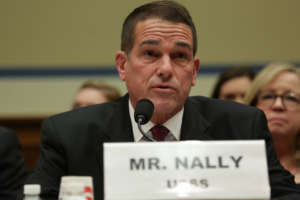
With Secret Service IT offices consolidated, Nally turns focus to innovation, modernization
Kevin Nally, the Secret Service’s chief information officer, is focusing on five strategic IT goals, including cybersecurity, the workforce and IT service...
The Secret Service consolidated and reconfigured how it manages and oversees technology over the last 18 months.
Now, it can better focus on its five strategic IT goals.
Kevin Nally, the Secret Service’s chief information officer, said his priorities around innovation, service delivery and cybersecurity will modernize the agency and give field agents access to technology and tools like never before.
Nally, who started in at the Secret Service in November 2015 after retiring from the Marine Corps after 34 years in that service, said former USSS Director Joseph Clancy told him to fix the technology oversight and management processes.

“To be a CIO, [I said to him] this is what I recommend and this is what I need to have happen. So he agreed to everything I presented. One was to take everything from Information Resources Management and move it under the CIO. Two was I had direct oversight over all IT spending. And three, I was the only designated approving authority for FISMA systems. He gave me the authority for all those three things. That was the first big thing,” Nally said on the Ask the CIO program. “The two biggest things are, number one, subsequent that I wrote a strategic plan and got that approved by the front office. My folks told me that this is the first time we’ve had a plan in a long time. So we are focused. I created five divisions and put GS-15s in charge of them and special agent Russ Wilson, my special agent in charge (SAC), is in charge of IT operations. So it’s actually paid big dividends. The other assistant directors like it the way we support them and we focus on the 1811s [special agents] and uniformed division officers on their requirements, and I don’t think they’ve had that for some time.”
The five divisions are:
- Cybersecurity;
- Program management office;
- IT operations;
- Enterprise architecture/governance and policy; and
- IT customer relations.
These five divisions are focusing on five goals: people, governance and policy, help desk and service delivery, innovative technology and cybersecurity.
“On innovative technology, it’s the capability and capacity to seamlessly interact from any location for any person, any organization with real-time information by providing the right information to the right person at the right time for mission success,” he said. “I’m fortunate to have the 1811s, the 12 of them that work with me in terms of knowing what the agents need in the field.”
Nally said among his top priorities is updating the Joint Operations Center (JOC) that supports the White House protective mission as well as the National Capital Region with new radios and antennas to better communicate and coordinate with other federal agencies, including FBI and Customs and Border Protection, and state and local law enforcement agencies.
“We also are researching additional mobile devices and how we can and will become operating system agnostic so we can have applications and programs on any type of platform,” he said.
All of these projects will be supported by a new voice, video and data infrastructure over the Internet called enabling capabilities (EC).
Nally said this converged infrastructure will run in the Secret Service’s private cloud and will support this effort through a 24/7 network operations center.
“It will be fully operational and capable by mid-to-late fiscal 2018. Basically it consolidates four separate networks, voice, video, data and radio that operate over our network. We will have improved bandwidth, faster network access and reduced downtime,” he said. “Laptops, smartphones and tablets will be able to be used for video conferencing, reducing the cost of leased lines. It implements enterprise WiFi throughout Secret Service locations in the continental U.S. so they will have the ability to connect to our network without being tethered to an Ethernet cable.”
Additionally under the EC initiative, Nally wants to add three petabytes of high-speed storage, and implement new and optimized cybersecurity tools around firewalls and intrusion prevention systems.
“We are working toward a single sign-on with the [smart identity] cards,” he said. “We will implement a new and optimized IT service desk and an improved ticketing system, and then implement new and optimized asset and configuration management tools.”
More Ask the CIO
The Secret Service already has reduced the number of privileged users by 85 percent.
“Most organizations don’t use the full capability or capacity of the [cyber] tools they buy. We are working to get up to speed on everything. For example, we have tool A and it does a certain amount of things, but we use it for one thing so if we are paying for it, why aren’t we using it to the full capacity?” he said. “We will sit down and ask ourselves, ‘if this tool does 10 things, are we using all 10?’ They will say, ‘no we are using two because either we don’t have the resources to do the other eight or we don’t know how to.’ Then we will go to the next option and bring in the vendor who will show us how to use the other eight.”
Nally said to make sure these projects are meeting their requirements he has developed an integrated master plan and schedule, and each part of the workforce plays a role.
He also is using the agile development methodology at the operational level.
Nally said he also has brought in the Defense Information System Agency’s Joint Interoperability Test Command (JITC) to help with some of the user interface and testing both from operational and cybersecurity perspectives.
One example of how the Secret Service has used agile to improve a back-office system is with the Uniform Division/Resource Management System (UDRMS).
The system lets Uniform Division officers schedule leave, training and other time off. The old system was a stack of binders and officers couldn’t schedule a day off more than three days in advance.
“Now they can do it on the phone,” he said. “It gives the UDR offices real time information to schedule time off and training schedules.”
Nally said there are several UDR officers who help test out the new system and are dedicated full-time to the development of the new system.
“As a new sprint is being rolled out, we get several UDR officers to come in and play with the system to see if it works based on how they want it to work and what information and data it provides them,” he said. “We get user buy-in up front and I think people like that.”
Copyright © 2025 Federal News Network. All rights reserved. This website is not intended for users located within the European Economic Area.
Jason Miller is executive editor of Federal News Network and directs news coverage on the people, policy and programs of the federal government.
Follow @jmillerWFED






